49+ Creator Platforms to Scale Your Business Profitably
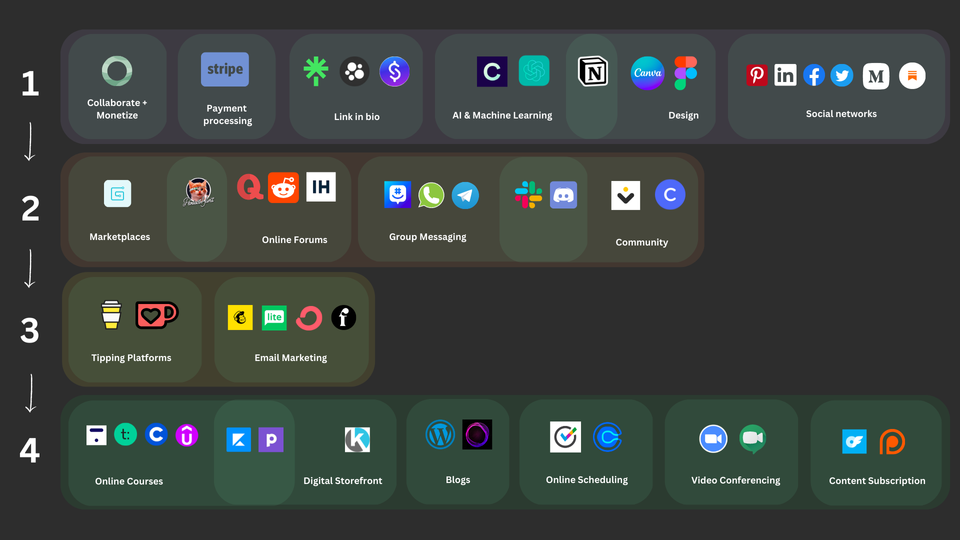
Let's get straight to the point. In reading this article, you will be saving over 720+ hours worth of time on market research and trying out numerous creator platforms.
Findings after 720+ hours of research
For full transparency, we've consulted with +2500 creators and entrepreneurs in this space, and 4 of the biggest mistakes well-intentioned hustlers make are:
- unnecessarily spending time and money on creator platforms at the wrong time
- spending time building a product before validating willingness to pay (WTP)
- not seeking daily feedback from potential customers and customers
- not using a data-driven approach to continuously improve
You likely have limited capital and a short timeline for getting your business off the ground and scaling. Because of this, you can't use every single creator platform overnight. You need to generate revenue quickly and get moving.
You don't just need to set up systems, you need to build sustaining processes that work, build upon each other, and compound quickly - a naturally growing machine that runs itself with minimal input from you.

Our goals with this article are to:
- present you with the parts of the machine you will ultimately build
- explain how each part works
- present how the parts fit together
- lay out the optimal order to set everything up
- introduce you to communities that can help you out
What you should expect
If you weren't aware, this article is written by the Kahana team. Are we going to mention Kahana? Absolutely. In fact, it's the first platform on the list.
Following the Iron Man analogy, we feel that Kahana is the central component of the machine - it's the arc reactor that powers the suit (we'll explain why shortly).
However, on a high level here is our perspective on all the creator platforms (including Kahana):
The truth is, there is no single platform that solves every problem, and that's why you need to properly combine multiple creator platforms to achieve your goals.
In the spirit of appreciating the strengths of all the platforms and how they work together, we arranged all the platforms we cover in this article into a Creator Platforms Landscape Diagram, which you can see below.
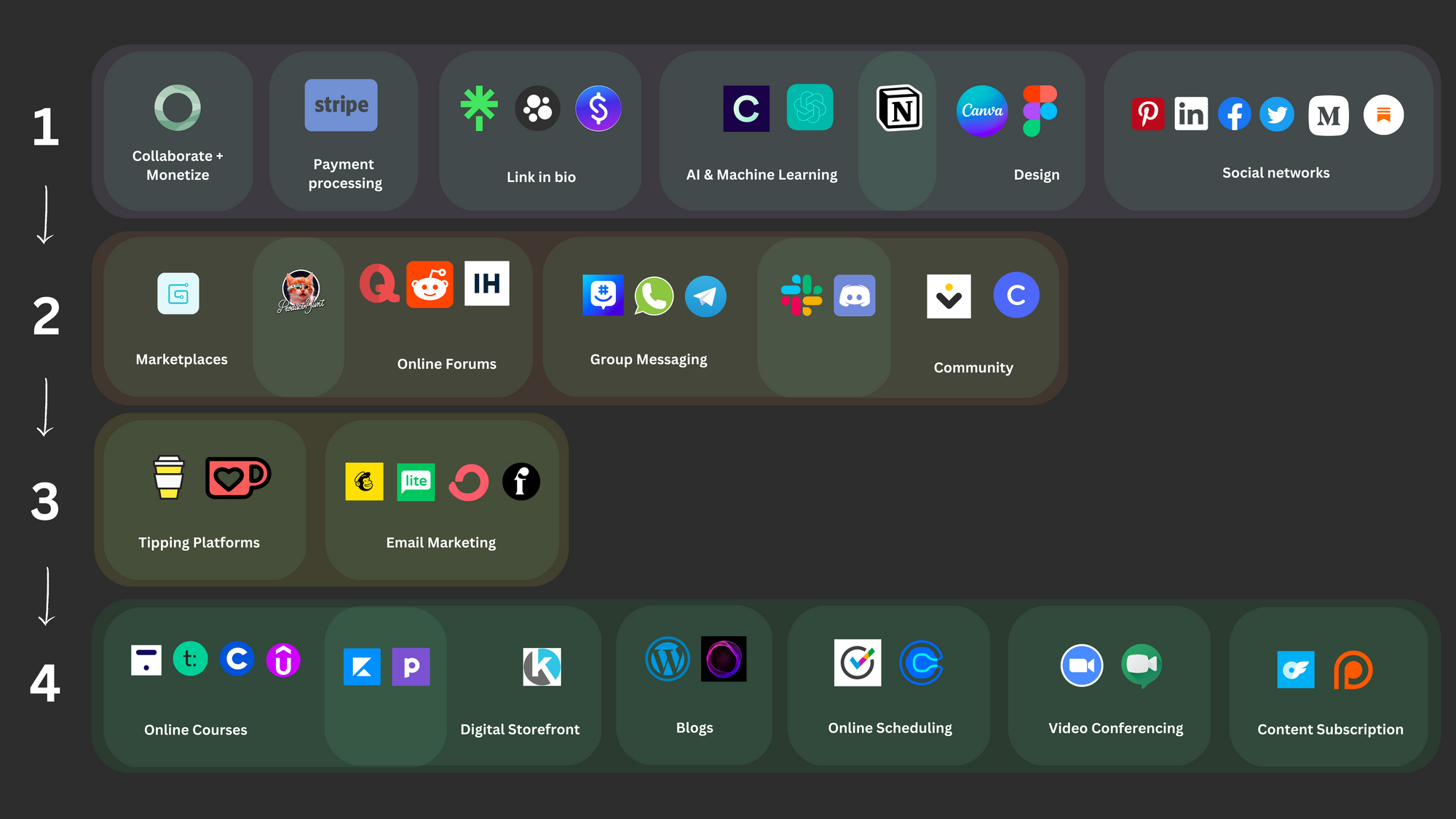
This diagram organizes all of the tools and platforms mentioned in this article into:
- Categories: collaboration and monetization (Kahana), Payment processing, link in bio, AI & machine learning, design, social networks, marketplaces, online forums, group messaging, community, tipping platforms, email marketing, online courses, digital storefront, blogs, online scheduling, video conferencing, content subscription.
- Stages 1, 2, 3, and 4
This article will cover the categories of platforms and the order in which you should set them up (how and why).
Key Assumptions
As you look at the diagram, you will realize that there are different platforms for each stage and this is by design. The stages are organized in a way that assumes:
- You have $0 in the bank to invest
- You have 0 followers on any platform
- You have 0 emails on an email list
If you are farther along than this, that's fine. You can still incorporate the techniques to improve what you've already done.
What you should not do: repeat people's costly mistakes
We've seen this exact scenario play out countless times. Without following the right steps, you could literally set out to create an online course, realize you need to upgrade all your video and editing equipment, spend $1000+ on equipment, spend 3 months creating and editing the course, release it without a waitlist of customers, and then get 0 sales.
Too many well-meaning creators, experts, and solopreneurs dive headfirst into "doing the thing," only to realize things like:
- you need at least 50K followers and engagement to get an ROI on a platform
- there are hidden server costs
- it's not actually free, it's a free trial
- the freemium versions of platforms won't get the job done
What you should do: fail fast, fail cheap, and learn from it
Instead of focusing on perfection, we recommend using Lean Thinking to fail fast, fail cheap, and learn. By properly setting up the creator platforms in Stages 1-3, you will be able to generate sustainable month-over-month revenue (MRR) with zero upfront investment.
For reference, it just takes an afternoon or two to actually sign up for the Stage 1 platforms and get your process moving before you start getting customer feedback and receiving initial payments.
Now with all that out of the way, let's scale your business for free!
Creating a Product and Accepting Payment
Before anything else, you must have an answer to the following question:
"Where do I pay??"
That's right. If a potential customer waltzes up to you and you don't have any price tags, products, or even a place to deposit money ... you're not in business.
Luckily, there's a simple answer.
Kahana 🆓
Kahana is a free collaboration and monetization platform. It allows you to create hubs of your content, knowledge, files, notes, media, etc., set a price, and accept payments to access. You can also invite and collaborate with other people directly in a hub to speed up the process of creating it.
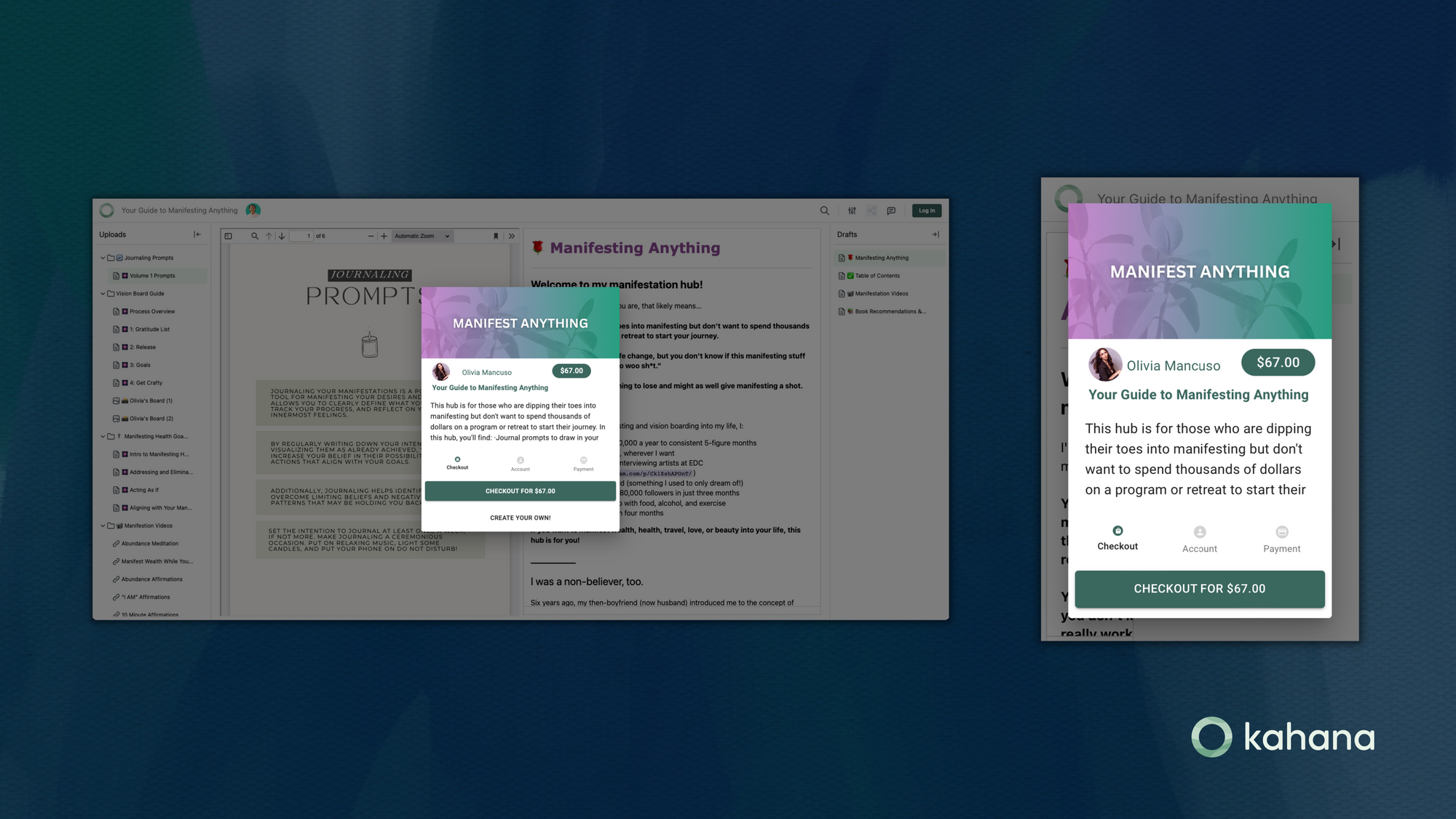
For example, the Manifestation Hub shown above was created by Olivia Mancuso, alongside the co-founders of Kahana, Jonathan Gans and Adam Kershner. The process of building the hub was streamlined due to the fact that the team collaborated asynchronously to upload, design, and curate the content.
Instructions for Kahana setup (takes ~20-25 minutes total)
- Create a free account and login
- Add a profile picture for your Kahana profile.
- Update key information - update the hub title, description, and cover photo (upload an existing photo or use Canva or Figma to create a landscape JPG or PNG).
- Click "Edit Monetization" and connect Stripe to Kahana
- Set an initial price on your hub and click the toggle "On"
- Preview how the hub will appear to potential customers by opening the link in a private or incognito window
- When you feel good about the state of your hub fill out this form to get on the Featured Hubs page
- Share your success! Drop your monetized hub link in a comment on this article or hit us up on Twitter or Instagram @KahanaHQ
Now, you may be asking yourself, "how does payment go to my bank account?"
Payment processing platforms
It's simple. You need to set up payment processing that connects to your bank account! Payment processing refers to the process of accepting and verifying payment transactions from customers and ensuring that the funds are transferred from the customer's account to the merchant's account. It involves various steps, including collecting payment information from the customer, verifying the information and authorizing the transaction, and settling the funds into the merchant's account.
Stripe 🆓
Stripe is a popular online payment processing platform that allows businesses and individuals to securely accept and manage online payments.
Having a Link in Bio to showcase your personal brand, help viewers find your profiles online, build waitlists for your hubs, and feature your hubs is a necessity. It only takes a few minutes and zero capital to create a Link in Bio, and it will provide you with a wealth of data and opportunities to scale your business.
Link in bio platforms
"Link in bio" refers to the hyperlink or call-to-action (CTA) button that users can add to their social media profile's bio section. It allows the user to share one clickable link that directs their followers to a webpage, product, or service of their choice. This is especially useful for creators, influencers, and businesses who want to drive traffic to a specific webpage or landing page without changing the URL in their profile frequently. Some social media platforms that allow users to add links in bios include LinkedIn, Pinterest, Facebook, Medium, and more.
Instructions for your Link in bio setup (takes ~10-15 minutes)
- Sign up for a Link in bio (Pensight is recommended)
- Add a profile picture (your headshot is recommended)
- Add information about yourself and your business in the bio
- Add links to your Kahana hubs or hub waitlists (you can create this with your Link in bio platform by using the "Email Form" feature)
- Add the URL to your link in bio to your social media profiles
Pensight 🆓
Pensight is the best free Link in bio option in our opinion. We're not affiliated with Pensight, but we recommend it to everyone that needs a link in bio site because it does a good job of allowing you to quickly build out a dynamic and visual landing page that screams, "I'm open for business, and I'm legit."
For inspiration, check out some of our creators' Pensight pages:
Linktree 🆓
Linktree is a platform that allows users to create a landing page with multiple links to different websites, social media profiles, and other online content. Users can add their links to the page and customize the look and feel of the page to match their brand.
Once the page is created, users can share the link to their Linktree page in their social media profiles, email signatures, or any other online platform where they want to provide a centralized location for their followers to access their content. When someone clicks on the Linktree link, they are taken to the user's landing page, where they can then choose which link they want to follow to access the user's content.
Beacons 🆓
Beacons is a platform that allows creators to easily create a personalized website to showcase their work, brand, and services. By connecting their social media accounts, creators can automatically import their content and display it in a clean, professional manner on their Beacons website. They can also include links to their other online presence, such as portfolios, online stores, and other social media profiles. Beacons.ai aims to simplify the process of building an online presence for creators and help them establish a stronger personal brand.
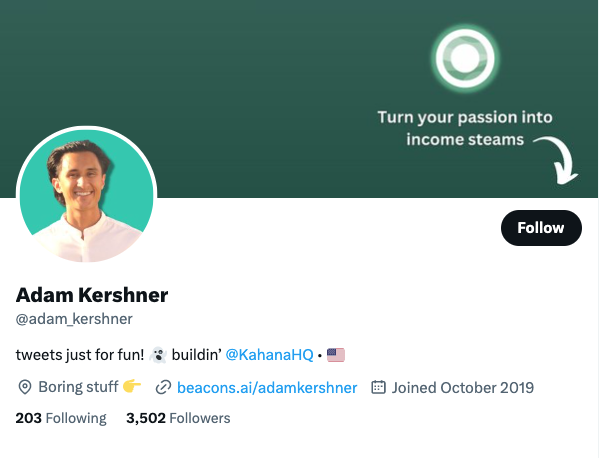
Stan 💰
Stan is a platform that positions itself as the ultimate "Link in Bio" store, distinguishing itself from similar services such as Beacons and Linktree. For a monthly subscription of $30, Stan offers a suite of tools for creators to manage and sell their digital products, including Kahana hubs, coaching calls, audits, and text messages.

After you have a Kahana, Stripe, and a Link in Bio setup, it's time to drive traffic to your stuff. The fastest way to do that is to share valuable content on the right social networks every day. The process of doing this will be covered in the next 3 sections:
- Social networking platforms
- Artificial intelligence (AI) & machine learning
- Design
Social networking platforms
Social networking platforms are online platforms that allow users to create a profile, connect with other users, and share content such as text, photos, videos, and links. Every social networking platform has different audience demographics, so make sure you choose the platform that contains individuals in your target audience.
LinkedIn 🆓
LinkedIn is a social networking platform that is primarily used for professional networking, job searching, and career development.
Audience demographics: LinkedIn Statistics for marketers 2023
Pinterest 🆓
Pinterest is a visual discovery and social media platform that allows users to discover and save images, videos, and other content to collections known as "boards". Users can search for content using keywords, hashtags, or by browsing through curated categories. They can also follow other users and boards to keep up with new content. Pinterest is popular among businesses and bloggers, who use the platform to showcase their products or ideas and drive traffic to their websites.
Audience demographics: Pinterest statistics in 2023
If you decide to use Pinterest, here is a hub about how to implement a successful Pinterest Strategy, created by Kelsey Vetter.
Twitter 🆓
With its concise format and widespread reach, Twitter continues to be a popular platform for sharing ideas and connecting with others.
Audience Demographics: Twitter Statistics and Trends
Substack 🆓
Substack is a platform that allows writers and publishers to create and distribute newsletters to their subscribers.
Audience Demographics: Substack Traffic Analytics & Market Share
Medium 🆓
Medium is an online publishing platform where people can share their stories, ideas, and perspectives on a wide range of topics.
Audience Demographics: Medium Traffic Analytics & Market Share
AI & Machine Learning
After you choose the social networks you want to focus on, you need to create content to drive traffic. In 2025, the fastest way to create posts for social media is to use AI & machine learning platforms.
ChatGPT 🆓
ChatGPT is an AI language model created by OpenAI based on the GPT (Generative Pretrained Transformer) architecture.
As a language model, ChatGPT can assist with content creation in several ways.
- Firstly, ChatGPT can provide ideas and suggestions for content topics based on the user's interests and preferences. It can also help users generate outlines and structure their content in a logical and coherent way
- Secondly, ChatGPT can help users improve the readability and clarity of their content by providing suggestions for word choice, sentence structure, and grammar.
- Thirdly, ChatGPT can assist with research and fact-checking by providing relevant information and sources on various topics.
For example, if you're making a hub about social media strategy, and you decide to market on Twitter, you can use ChatGPT to create those Tweets. All need to do is type "write 10 tweets about how to get views on Twitter" into ChatGPT, and the program will create a list of Tweets for you to consider.
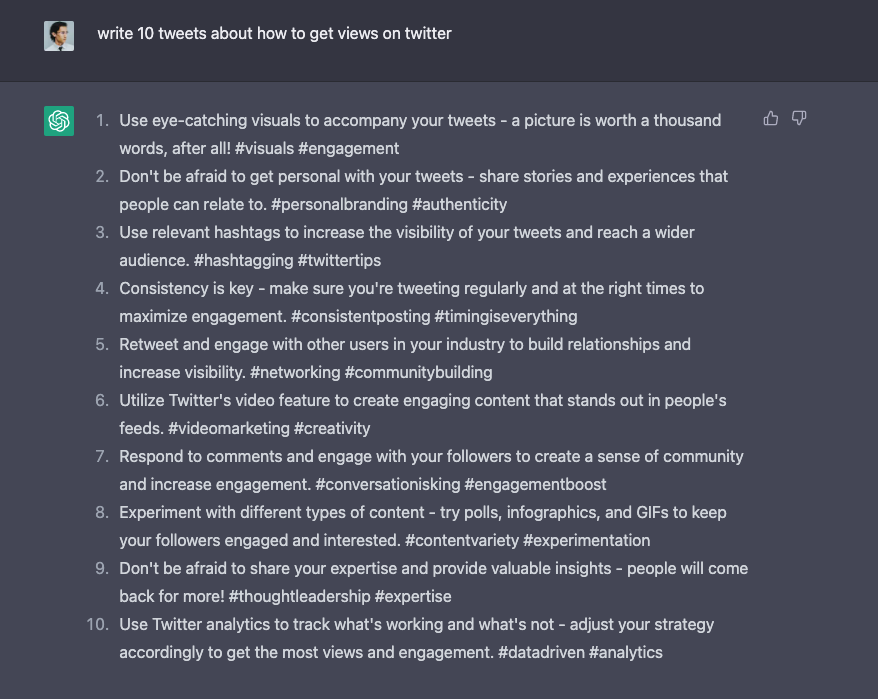
Using ChatGPT is a great starting point, but you also need to fact-check and verify the accuracy of your content. Don't just go copy-and-pasting content directly from ChatGPT.
Copy.ai 🆓
Copy.ai is an AI-powered writing tool that uses machine learning models to help users generate high-quality written content. It provides a user-friendly interface where users can input a few words or phrases related to the content they want to create, and then the tool generates multiple variations of content based on the input.
Copy.ai is designed to help users create marketing copy, ad copy, social media posts, blog articles, product descriptions, and more. The tool uses natural language processing and machine learning algorithms to understand the context of the input and generate content that is both grammatically correct and contextually appropriate. It also allows users to customize their output by selecting the tone, style, and structure of the generated content.
Design
While it isn't the main focus of the strategy, graphic design is an aspect of getting set up. For example, you will need header images for your social media and link in bio profiles. You will also need to add a cover photo for your Kahana hub. While you don't need to create and post a ton of images on social media, including some images like infographics, checklists, or tips can go a long way. In general, you will need to have a graphic design platform ready for small needs as they arise.
Canva 🆓
Canva is a popular graphic design platform that allows users to create a wide range of visual content such as social media graphics, presentations, posters, flyers, and much more. It provides an easy-to-use interface, a vast library of templates, images, and design elements, as well as the ability to upload custom images and fonts.
Here is a link to a free hub cover template made with Canva. You can use it to create a cover, download it as PNG, and upload it to your hub.
Figma 🆓
Figma is a web-based vector graphics editor and prototyping tool used for user interface and user experience design of web applications. It allows multiple designers to work on the same design simultaneously and provides real-time collaboration features.
Productivity
To tie everything together, you should use productivity tools to stay organized and on schedule.
Notion 🆓
Notion is an all-in-one workspace application that allows users to create and organize notes, tasks, databases, wikis, and other types of content in a highly customizable manner. It can be used for personal productivity, team collaboration, project management, and more. Notion offers a range of features such as templates, databases, kanban boards, calendars, and integrations with other tools.
Notion also offers abilities to design workspaces that can be included as links in your Link in bio as well as generate content with writing AI.
Instead of starting from scratch, you can get started with this Easy Notion Second Brain template that we created, including dynamically updating calendars, task lists, and spaces for hubs.
Taking advantage of marketplaces is simple: put your product where people are looking for products. By doing this, you can rapidly increase the number of views you get on your hubs and also build your followings on social media through your Link in bio.
Marketplaces
An online marketplace is a platform that connects buyers and sellers over the Internet, facilitating transactions between them. In general, these marketplaces can be used to buy or sell various goods or services, such as physical products, digital products, freelance services, or even rental properties.
Product Hunt 🆓
Product Hunt is an online platform that enables entrepreneurs, developers, and makers to showcase their products to a large audience of tech enthusiasts and early adopters. The platform allows registered users to discover new and innovative products, upvote their favorites, leave comments, and interact with the makers. Each day, the most upvoted products are highlighted on the platform, driving more visibility and potential users. Additionally, Product Hunt offers various tools for makers, such as launch support, feedback, and community engagement resources.
Example of a Product Hunt page:

Gumroad 🆓
Gumroad is an online platform that allows creators to sell digital and physical products directly to their audience. The platform offers an interface where creators can upload and sell their products, including ebooks, courses, videos, music, art, and more.

One of the best ways to use Gumroad is to create free products to get emails and traffic to your pages. You can create a landing page for your hub on Gumroad and include the link. This way the product can be discovered through Gumroad's search features. People are looking for products like yours on Gumroad, so you can spend a bit of time creating a free account and publishing your hub as a product there. Just remember to include the link in the description of the landing page content so people can access it directly.
If you want inspiration for how to create products and landing pages on Gumroad, feel free to check out Kahana's Gumroad store.
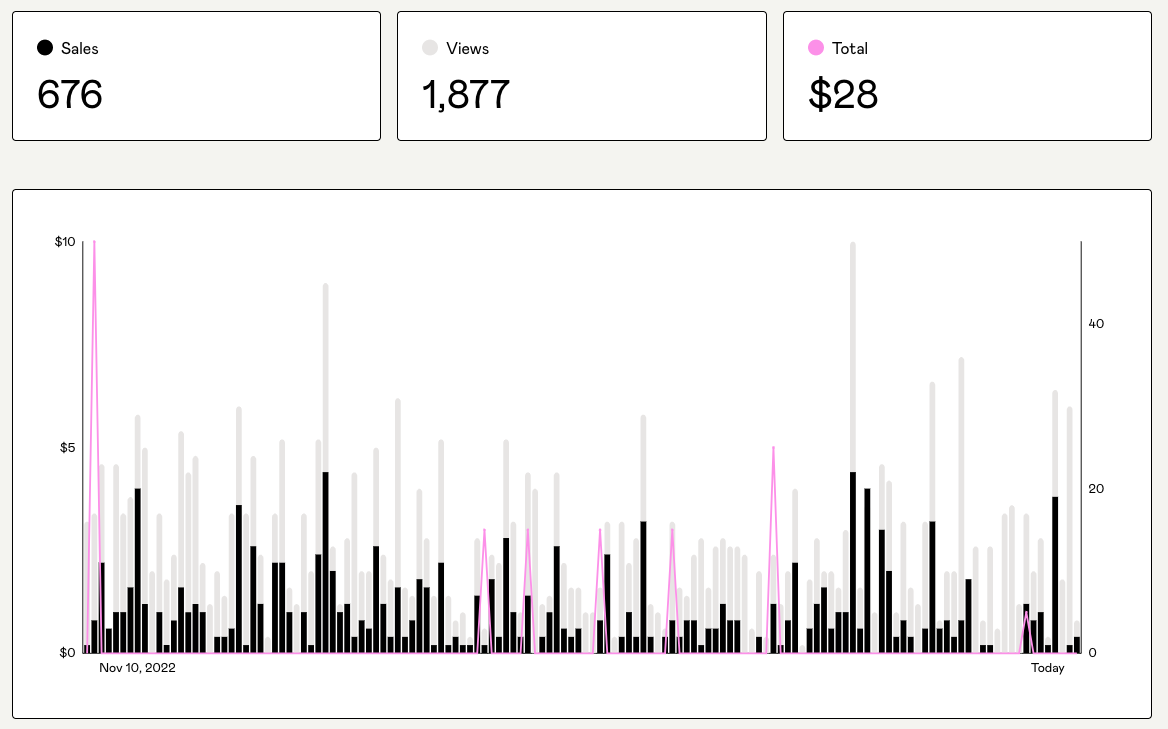
In addition to marketplaces, online forums are excellent ways to place your product directly where people are seeking information. Whenever you search for an answer to a question, there is a good chance you will find yourself in an online forum. To take advantage of forums to increase your distribution and sales volume, all you need to do is find questions relevant to your monetized hub and provide answers, including a link to your hub.
Online Forums
Online forums, also known as discussion boards or message boards, are online platforms where users can post messages, engage in conversations and discuss various topics with other users. They provide a space for people to connect, share ideas and opinions, ask questions, and seek advice on a wide range of topics, such as hobbies, politics, education, business, and more.
Quora 🆓
Quora is a question-and-answer platform where users can ask and answer questions on a wide range of topics. It was founded in 2009 and has grown to become one of the most popular Q&A sites on the internet. Quora allows users to follow specific topics, contribute their knowledge to the platform, and vote on the best answers to each question. The platform has a large and diverse community of users, including experts and professionals in various fields.
For example, if you create a hub about "how to grow an audience," you can just type "How to grow an audience quora" into Google and find multiple threads where you can post and answer and include a link to your hub.
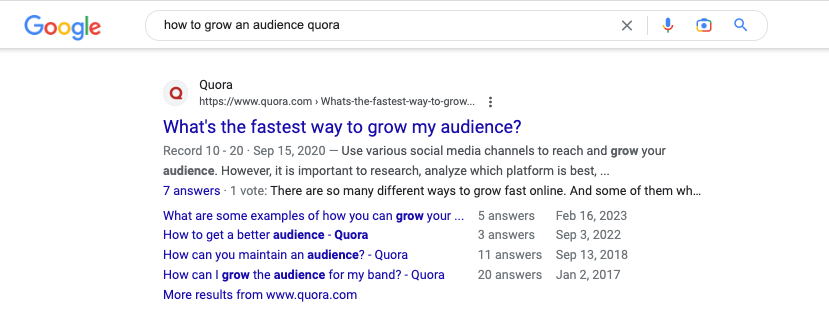
Reddit 🆓
Reddit is a social news and discussion website where users can submit content in the form of text posts, links, images, and videos, and other users can then upvote or downvote these posts and comment on them. It is organized into numerous communities called subreddits, each dedicated to a specific topic or interest. Reddit is known for its vast and diverse user-generated content, from breaking news to memes, and for its active and engaged community of users who contribute to discussions, share information, and offer advice on a wide range of topics.
The same example used above with Quora remains true for Reddit. If you create a hub about "how to grow an audience," you can just type "How to grow an audience reddit" into Google and find multiple threads where you can post and answer and include a link to your hub.
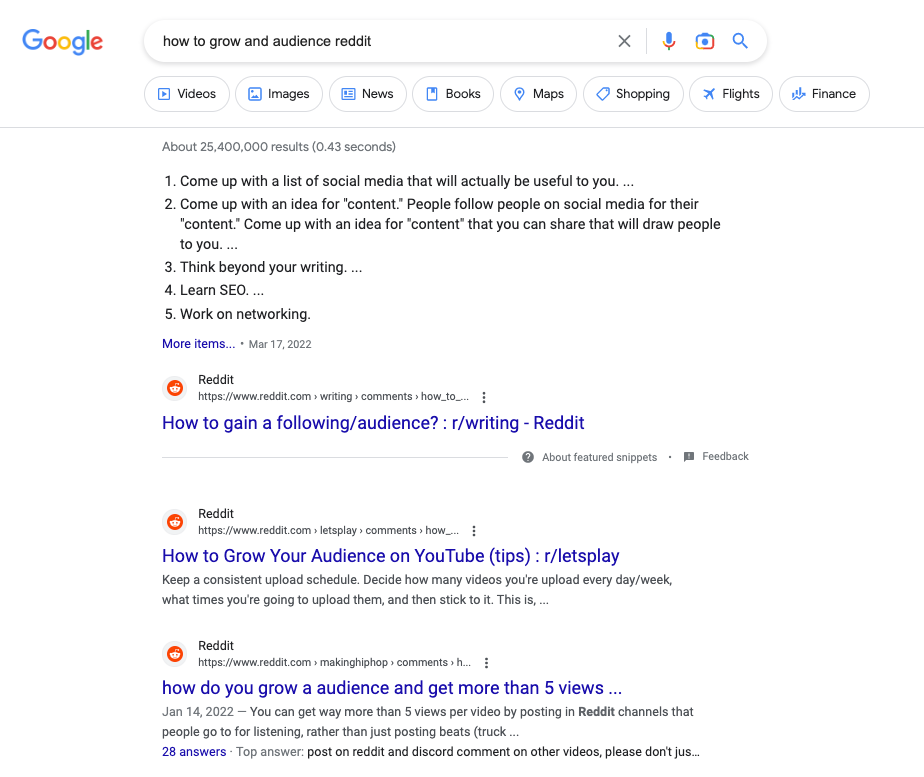
You can also create your own community on Reddit and add it as a link in your bio. This is a good way to begin building a community and answering questions about your hubs. For reference, here's our Kahana App Reddit community:
IndieHackers 🆓
IndieHackers is an online community that brings together entrepreneurs, founders, and makers who are interested in creating and growing profitable online businesses. The platform provides a supportive environment for members to share their experiences, ask for advice, and connect with like-minded individuals. Members can also access a range of resources and tools to help them develop their businesses, including interviews with successful entrepreneurs, case studies, and a job board.
After you set up all the systems mentioned above and you're posting daily on social media platforms, you will likely be seeing growth in followers organically on social media. You will also be receiving a lot of new traffic on your Link in bio page and hubs. At this point, you can begin to focus on engaging even more with your audience and create spaces for your biggest fans and customers to gather. This will help you connect more closely with customers and get real-time feedback (not over email). Even if you don't like group chats or messaging, it's still something to consider as a tool to directly support your customers (which you'll likely have at this point if you've done everything above).
Group Chat & Messaging Platforms
Group messaging platforms are online communication tools that allow users to send messages, voice notes, videos, and other media to a group of people simultaneously.
Discord 🆓
Discord is a communication platform that enables users to create and participate in online communities, primarily for gaming and social purposes. Users can create or join servers, which are essentially chat rooms with various channels for different topics. Within these channels, users can send text, voice, and video messages to communicate with each other.
Discord also allows users to create voice and video calls with other users or groups of users, as well as screen sharing for collaboration and sharing content. Users can also share images, videos, and links within the platform.
In addition to these features, Discord also supports integrations with other apps and services, such as Spotify and Twitch, to allow users to share their activities and content from these platforms within their Discord communities. Discord also supports various moderation tools and user roles to help maintain a safe and enjoyable community experience.

Slack 🆓
Slack is a team communication and collaboration platform that is used by organizations to improve internal communication and productivity.
Groupme 🆓
GroupMe is a messaging app that allows users to create and join group chats.
WhatsApp 🆓
WhatsApp is a messaging app that allows users to send text messages, and voice messages, make voice and video calls, and share images, videos, documents, and other media.
Telegram 🆓
Telegram is a cloud-based instant messaging and voice-over IP service that allows users to send and receive messages, photos, videos, and files of any type up to 2 GB. It also supports end-to-end encrypted messaging, voice and video calls, and allows users to create channels and groups for broadcasting messages to large audiences. Telegram also has a feature called "Secret Chats" that allows users to send self-destructing messages with end-to-end encryption.
Using community-building platforms is a way to build more of an experience around your online business. As you create hubs and post content on social media, people will gravitate to you out of mutual interest in the topics you post about, and they will likely want to collaborate with you to build hubs and monetize. To support this, you can use community-building platforms to allow people in your audience to meet with each other, connect with you, help with building new hubs, and of course provide feedback on your hubs.
Community Building
Online community building refers to the process of creating, nurturing, and engaging a group of people who share common interests, goals, or values in a digital space. It involves leveraging various online tools and platforms to facilitate communication, collaboration, and networking among community members. Online communities can be formed around a variety of topics, such as hobbies, professional interests, causes, or geographic locations. Successful online community building involves developing a clear mission or purpose for the community, establishing guidelines and rules for participation, and providing regular opportunities for members to connect and engage with one another.
Facebook Groups 🆓
Facebook Groups are online communities created on the Facebook platform where people can come together around a shared interest or goal.
Facebook Groups offer a way for people to connect and interact with others who share similar interests or goals. It can be a valuable tool for businesses, organizations, and communities to communicate and engage with their audience.
Nas 🆓
Nas is a platform that helps people manage a community with exclusive memberships, courses, and events.
Circle 💰
Circle is a platform that allows creators to build their own community websites. Its basic plan starts at $49 / month.

With Tipping Platforms, we've reached Stage 3 of your journey, where you are mainly focused on growing profits quickly and addressing more customers. This one isn't rocket science - you can simply spend 1-2 hours setting up a "Tip Jar" and add it to your Link in bio for people that just want to support you out of the kindness of their heart. You can thank these folks by giving them shoutouts on social media.
You can also use tipping platforms to gather testimonials about your hubs and display them all in one place. You can position the tipping pages like "What my customers/clients say" and showcase customer love for people who consider your hubs in the future.
Tipping Platforms
Online tipping platforms are digital tools that allow users to give monetary tips or gratuities to creators or service providers through online transactions. These platforms provide an easy and convenient way for audiences to support their favorite creators or tip service providers for a job well done. Examples of online tipping platforms include Patreon, Ko-fi, Buy Me a Coffee, and Tip Jar.
Buymeacoffee 🆓
BuyMeACoffee (BMAC) is a platform that allows creators to receive support from their fans by receiving one-time or recurring payments. Creators can set up a page on the platform, where they can showcase their work and ask their fans to buy them a "coffee" or make a donation. The platform offers various features, including the ability to offer exclusive content to supporters, integrations with other tools, and more. BuyMeACoffee charges a small fee on transactions made through the platform, and creators can withdraw their funds via PayPal or Stripe.
Ko-Fi 🆓
Ko-fi is a platform that allows creators to receive support and funding from their fans, followers, and supporters. Supporters can show their appreciation for the creator's work by buying them a "coffee" or contributing a one-time donation.
Email marketing can be powerful when you have established email lists of 500-1000+ people. You will naturally accrue the emails of people that pay for access to your hubs, from Gumroad free downloads, and from anyone who signs up for waitlists from your Link in bio. Once you have a bunch of emails, you can spend some time segmenting your audience and send them relevant updates about potential new products (e.g. new hub links).
Email Marketing
The main purpose of email marketing is to build relationships with customers, generate leads, and increase sales by promoting products, services, or brand awareness through emails. Email marketing can be done using email automation software or manually, and it typically includes personalized messages, newsletters, and promotional offers.
Mailchimp 🆓
Mailchimp is an email marketing platform that allows users to create and send emails to their subscribers.
Mailerlite 🆓
MailerLite is a cloud-based email marketing platform that allows businesses to create and send email campaigns to their subscribers.
ConvertKit 🆓
ConvertKit is an email marketing tool used by bloggers, creators, and small business owners. It is designed to help users build and manage email lists, create and send newsletters, and automate email marketing campaigns.
Flodesk 💰
Flodesk is an email marketing platform that allows users to create and send visually stunning and personalized emails to their subscribers. Flodesk costs $38 / month.
Now, we've reached Stage 4 of the journey, where you're focused on diversification and raising prices. At this point, you've built an audience, learned a lot, and have a track record of success. You have the ability to increase your prices or add new product lines that are higher ticket items, like online courses or consulting sessions.
Online Courses
Online courses are digital educational programs that allow learners to access course materials and complete coursework online. Many online courses also offer interactive features such as discussion forums, live video lectures, and online office hours to facilitate collaboration and engagement between students and instructors.
The problem with online courses is that they are time-consuming and capital-intensive to create. We only recommend creating an online course if your audience truly demands it and prepays to be on a waitlist for it when it comes out. Otherwise, you run the risk of losing time and money on the project.
Thinkific 🆓
Thinkific is a cloud-based learning management system (LMS) that allows users to create, market, and sell online courses.

Teachable 🆓
Teachable is a cloud-based platform that allows creators to easily create and sell online courses.

Coursera 🆓
Coursera is an online learning platform that offers courses, certificates, and degree programs from top universities and organizations.

Udemy 🆓
Udemy is an online learning platform that allows instructors to create and offer courses on a variety of topics.
Kahana can complement Udemy by providing instructors with an additional platform to monetize their expertise and content. Instructors can use Kahana to create and distribute content that may not fit into the traditional course format of Udemy. Kahana's flexible monetization tools also enable instructors to experiment with different pricing models and revenue streams.

When you already have 10 or more products (hubs), then it can begin to make sense to have a more robust digital storefront. Having a storefront to help customers search and find products is helpful when a Link in bio simply cannot contain all of the products in a digestible way. It makes sense to migrate to keep your Link in bio as the main call-to-action (CTA) on your social media profiles, but include a link in it that goes to your digital storefront with "All products."
Digital Storefront
A digital storefront is an online platform or website where businesses can sell their products or services directly to customers. It is a virtual equivalent of a physical store where customers can browse and purchase products online.
Podia 🆓
Podia is an all-in-one digital storefront where creators can sell online courses, memberships, and digital downloads. Users can customize their storefronts, create and manage their products, set pricing and discounts, and accept payments. Podia also offers email marketing tools and integrations with other platforms.
Kartra 💰
Kartra is an all-in-one marketing automation platform that allows businesses and entrepreneurs to build and manage their online presence, including websites, landing pages, sales funnels, email marketing campaigns, and more. It also includes features for membership sites, course creation, affiliate management, and analytics. Kartra plans start at $100 / month.

Kajabi 💰
Kajabi is an all-in-one platform for creating and selling digital products, including online courses, membership sites, and coaching programs. It allows creators to easily build and customize their online presence, manage their content, and sell their products through various channels. Kajabi provides tools for website building, email marketing, course creation, community management, and more. Kajabi plans start at $149 / month.

Having a blog is a great way to educate your customers about your products. Heck - that's why we have one! However, creating a blog is extremely time-consuming, requires technical skill, and always costs some money to do it right (quality hosting, servers, etc.). Don't be deceived, having a blog is not easy, however, it can accelerate your revenue once you've established your audience and products.
Blogging Platforms
Blogs are websites or sections of websites that regularly feature content, usually in the form of written articles or posts. Blogs can cover a wide range of topics and can be authored by individuals or organizations. They may include text, images, videos, and other multimedia elements, and often allow readers to leave comments and engage in discussions with the author and other readers.
WordPress 🆓
WordPress is a free and open-source content management system (CMS) that allows users to create and manage websites, blogs, and online stores.
Ghost 💰
Ghost is a modern, open-source content management system (CMS) designed specifically for publishing content such as articles, blog posts, and news on the web. Ghost.io offers a simplified and streamlined interface that is easy to use for bloggers, writers, and content creators. It has a range of features such as customizable themes, built-in SEO tools, and the ability to integrate with other tools and services. Ghost plans start at $30 / month.
Similar to online courses, strategy sessions or consulting meetings can be a great way to add more product options to your online business. However, this assumes you actually want to do these types of interactive meetings. It's not for everyone, however, with hubs set up and paying customers, 1:1 sessions often work as a logical upsell. To accomplish this, you need an online scheduling system and a video conferencing solution.
Online Scheduling
Online scheduling is the process of using software or tools to schedule appointments, meetings, or other events through the internet. It eliminates the need for manual scheduling, allowing users to book appointments online and receive reminders via email or text.
OnceHub 🆓
OnceHub is an online scheduling platform that provides a range of tools for businesses and professionals to schedule appointments, meetings, and services with their clients or customers. It offers features like customizable booking pages, automatic scheduling, video conferencing integrations, payment processing, and more.
Calendly 🆓
Calendly is an online scheduling tool that helps users set up and manage appointments with clients or colleagues. Users can create custom scheduling links that sync with their calendar, share the link with others, and allow them to easily schedule a meeting based on available time slots. Calendly also sends email reminders and confirmations, and can integrate with other tools like Zoom and Google Meet for virtual meetings.
Video Conferencing
You probably already know this, but video conferencing is a technology that enables people to hold virtual meetings, presentations, and discussions over the internet. It allows participants to see and hear each other in real-time, just like in a face-to-face meeting.
Zoom 🆓
Zoom is a video conferencing platform that allows users to host and join meetings online. It provides a range of features such as screen sharing, recording, virtual backgrounds, and breakout rooms, among others. Users can join Zoom meetings through a web browser, the Zoom desktop or mobile app, or by dialing in through a phone. Zoom has become increasingly popular for remote work, online learning, and virtual events. It offers various pricing plans, including a free plan with limited features, and has integrations with other tools such as Google Calendar and Slack.
Google Meet 🆓
Google Meet is a video conferencing tool developed by Google as a part of the Google Workspace (formerly G Suite) platform. It allows users to host and join video meetings with up to 250 participants at a time, depending on the license or plan.
Google Meet offers features such as screen sharing, real-time captions, recording, virtual backgrounds, and integration with other Google Workspace apps like Google Calendar and Gmail. It is accessible on web browsers as well as mobile devices through the Google Meet app.
Lastly, you may come across content subscription platforms along your journey. These platforms are good to be aware of, but you don't need them, and they would likely come into play once you've built an audience that is over 100,000 people. Mainly they provide new avenues to interact with your content e.g. tiers and bundling. Good to be aware of, but not something to consider until you've established a sizable following (and that's not even something you have to do).
Content Subscription Platforms
A content subscription platform is a tool or service that allows creators to monetize their content by offering it to their audience through a subscription-based model. These platforms typically provide a centralized space where creators can upload their content, set subscription fees, and manage their subscriber base. Content subscription platforms can be used by a wide range of creators, including writers, musicians, podcasters, artists, and more. Some popular examples of content subscription platforms include Patreon, OnlyFans, Substack, Medium, and Kahana.
Patreon 🆓
Patreon is a platform that enables creators to receive recurring payments directly from their supporters or "patrons." Creators can offer various tiers of benefits and exclusive content to patrons in exchange for their ongoing support.

OnlyFans 🆓
OnlyFans is a subscription-based content platform that allows creators to monetize their content by offering exclusive access to their fans for a fee. The platform is known for adult content, but creators from a wide range of industries use it to offer exclusive access to their work and build a community of dedicated fans. OnlyFans takes a percentage of the revenue generated by creators as a fee for hosting the platform and providing payment processing and other services.

That's a wrap! 🌯
Quick answers
If you have suggestions to improve this article or questions you'd like to ask, here's what you can do:
- 🐦 Tweet us directly @KahanaHQ (fastest!)
- 💬 Leave a comment below
- 🗣️ Visit our Help Center

Talk with a Kahana representative
Fill out your information and a Kahana team representative will reach out to you. Have a simple question? Search our library of articles


